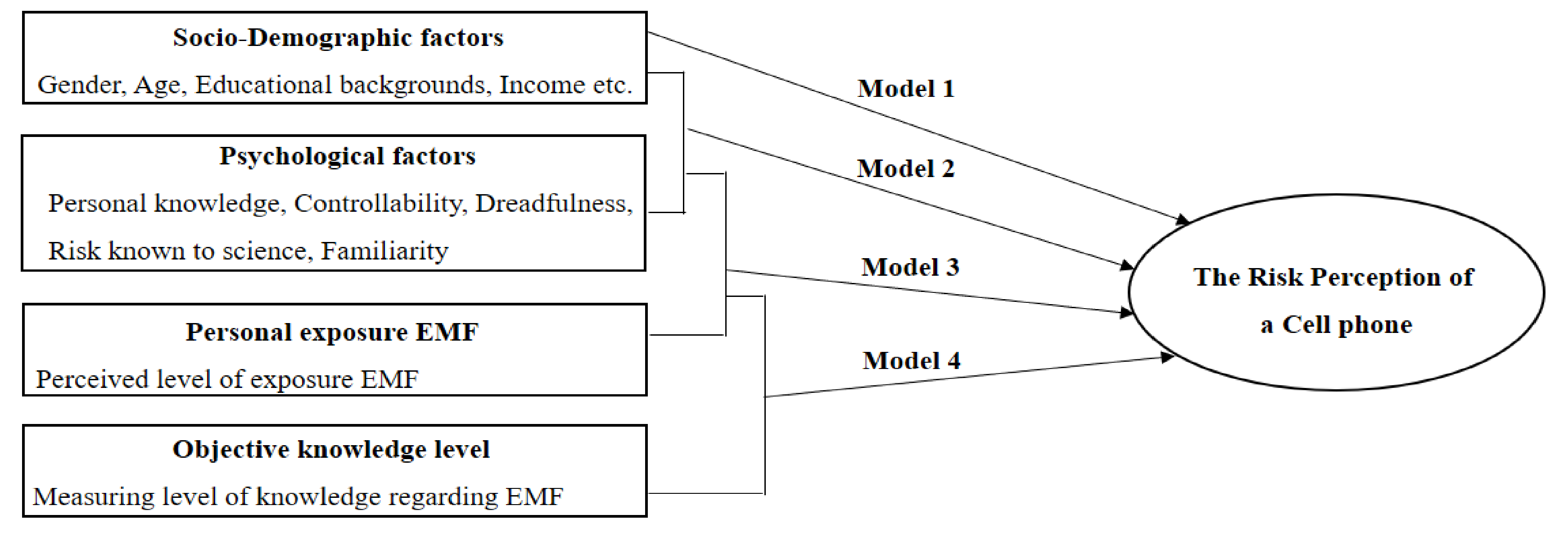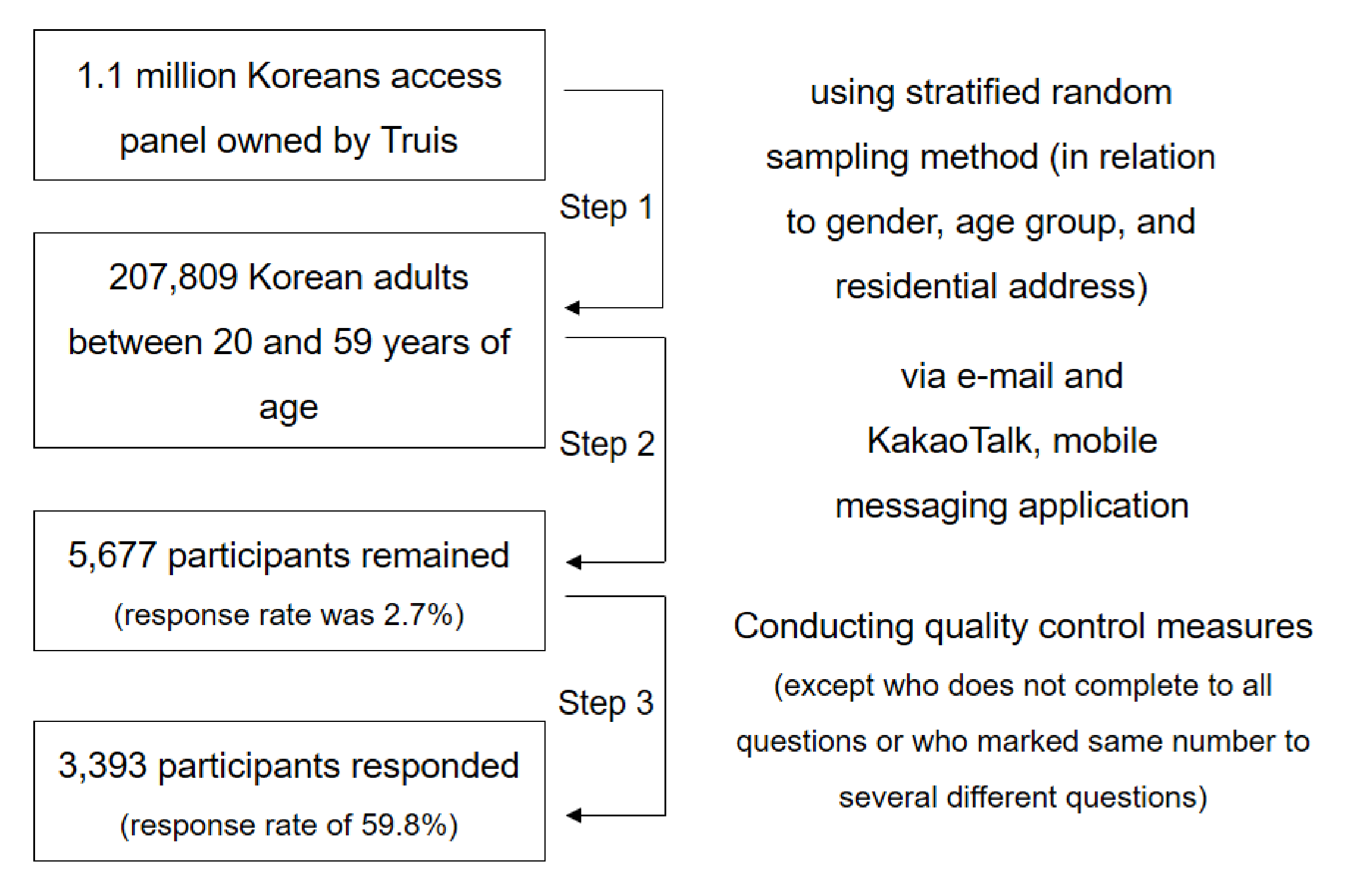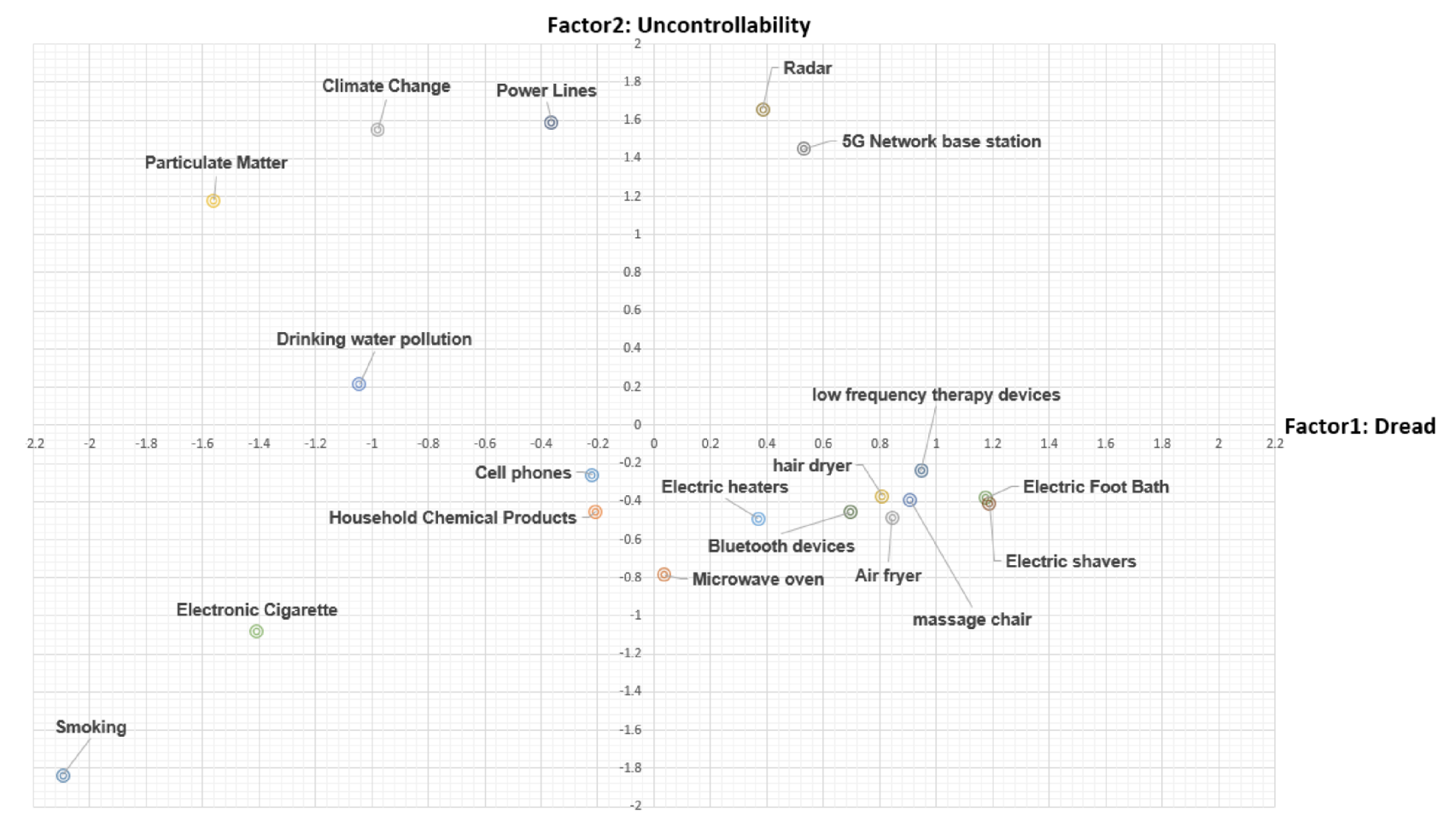The Relationship between Risk Perception of Cell Phones and Objective Knowledge of EMF in Korea
Abstract
1. Introduction
2. Materials and Methods
2.1. Research Questions
- RQ 1)
- What are the factors influencing the risk perception of cell phones?
- RQ 2)
- Does the level of knowledge of EMF affect the risk perception of cell phones?
- RQ 3)
- How much do socio-demographic characteristics, psychological factors, perceived level of exposures to EMF, and objective knowledge regarding EMF affect the risk perception of cell phones?
2.2. Patient and Public Recruitment
2.3. Study Subjects in Survey
2.4. Questionnaire
2.5. Statistical Analysis
2.6. Ethics Statement
3. Results
3.1. Socio-Demographic Characteristics
3.2. The Variables Affecting the Risk Perception of Cell Phones
3.3. The Risk Cognitive Map on Electromagnetic Fields around the Public
4. Discussion
5. Conclusions
Author Contributions
Funding
Acknowledgments
Conflicts of Interest
References
- Pew Research Center. Smartphone Ownership is Growing Rapidly around the World, but not always Equally. 2019. Available online: https://www.pewresearch.org/global/2019/02/05/smartphone-ownership-is-growing-rapidly-around-the-world-but-not-always-equally/ (accessed on 30 September 2020).
- Generalized EMF Research using Novel Methods (GERoNiMO) Project. Available online: https://radiation.isglobal.org/geronimo/ (accessed on 4 August 2020).
- Cohort Study of Mobile Phone Use and Health (COSMOS) Project. Available online: http://www.thecosmosproject.org/ (accessed on 4 August 2020).
- Radio Frequency Electromagnetic Fields Exposure and Brain Development (REMBRANDT). Available online: https://www.isglobal.org/en/-/radiofrequency-electromagnetic-fields-exposure-and-brain-development-from-exposure-assessment-to-dose-response-assessment-rembrandt- (accessed on 1 October 2020).
- Study on Communication Technology, Environment and Brain Tumors in Young People (Mobi-Kids Study). Available online: http://www.mbkds.net/ (accessed on 4 August 2020).
- International Agency for Research on Cancer. Supplemental Information for the Vermont Senate Finance Committee: The WHO IARC Listing of RFR as a Possible Human Carcinogen and Implications. Available online: http://www.aqlpa.com/sites/ass-010-aqlpa/files/files/ondes%20electromagnetiques/20120227_OMS%20CIRC%20%202B%20toute%20sources%20de%20micro-ondes%20pages-1.pdf (accessed on 30 September 2020).
- Sandman, P.M. Risk Communication: Facing Public Outrage. Manag. Commun. Q. 1987, 2, 235–238. [Google Scholar] [CrossRef]
- Zwick, M.J. Risk as perceived by the German public: Pervasive risks and “switching” risks. Risk Res. 2005, 8, 481–498. [Google Scholar] [CrossRef]
- Wiedemann, P.M.; Freudenstein, F.; Böhmert, C.; Wiart, J.; Croft, R.J. RF-EMF Risk Perception Revisited: Is the Focus on Concern Sufficient for Risk Perception Studies? Int. J. Environ. Res. Public Health 2017, 14, 620. [Google Scholar] [CrossRef] [PubMed]
- MacGregor, D.G.; Slovic, P.; Morgan, M.G. Perception of risks from electromagnetic fields: A psychometric evaluation of a risk—Communication approach. Risk Anal. 1994, 14, 815–828. [Google Scholar] [CrossRef] [PubMed]
- Morgan, M.G.; Slovic, P.; Nair, I.; Geisler, D.; MacGregor, D.; Fischhoff, B.; Lincoln, D.; Florig, K. Powerline frequency electric and magnetic fields: A pilot study of risk perception. Risk Anal. 1985, 5, 139–149. [Google Scholar] [CrossRef] [PubMed]
- Freudenstein, F.; Wiedemann, P.M.; Varsier, N. Exposure knowledge and risk perception of RF EMF. Front. Public Health Radiat. Health 2015, 2, 1–8. [Google Scholar]
- EC (European Commission). The Europeans and Modern Biotechnology: Eurobarometer 46.1. European Commission: Brussels, 1997. Available online: http://ec.europa.eu/public_opinion/archives/ebs/ebs_108_en.pdf (accessed on 21 January 2009).
- Sjöberg, L.; Drottz-Sjöberg, B.M. Knowledge and risk perception among nuclear power plant employees. Risk Anal. 1991, 11, 607–618. [Google Scholar] [CrossRef] [PubMed]
- Siegrist, M.; Earle, T.C.; Gutscher, H.; Keller, C. Perception of mobile phone and base station risks. Risk Anal. 2005, 25, 1253–1264. [Google Scholar] [CrossRef] [PubMed]
- Yaguchi, H.; Nobutomo, K.; Shingu, K.; Miyakoshi, J. Attitudes of undergraduate students to electromagnetic fields. Int. Med. J. 2000, 7, 265–272. [Google Scholar]
- Johnson, B.B. Advancing understanding of knowledge’s role in lay risk perception. Risk 1993, 3, 189–212. [Google Scholar]
- Kim, K.-H.; Kim, H.-J.; Song, D.-J.; Cho, Y.M.; Choi, J.-W. Risk Perception and Public Concerns of Electromagnetic Waves from Cellular Phones in Korea. Bioelectromagnetics 2014, 35, 235–244. [Google Scholar] [CrossRef] [PubMed]
- Ock, M.; Lim, S.Y.; Kim, H.J.; Ryu, H.M.; Yi, N.; Lee, M.-S. Perceptions of Healthcare Workers of Health Risks of Electromagnetic Fields. Korean J. Health Promot. 2015, 15, 39–46. [Google Scholar] [CrossRef]
- Jung, J.-S.; Lee, Y.-J.; Kawshalys, R.; Lee, J.-W.; Hong, S.-C. Study of ELF-MF exposure levels in living environment and perception of EMF for elderly groups. J. Odor Indoor Environ. 2017, 16, 218–225. [Google Scholar] [CrossRef]
- Slovic, P. Perception of risk. Science 1987, 236, 280–285. [Google Scholar] [CrossRef] [PubMed]
- Slovic, P. Trust, emotion, sex, politics, and science: Surveying the risk-assessment battlefield. Risk Anal. 1999, 19, 689–701. [Google Scholar] [CrossRef] [PubMed]
- Dunwoody, S.; Neuwirth, K. Coming to terms with the impact of communication on scientific and technological risk judgments. In Risky Business: Communicating Issues of Science, Risk, and Public Policy; Wilkins, L., Patterson, P., Eds.; Greenwood: New York, NY, USA, 1991; pp. 11–30. [Google Scholar]
- Gustafson, P. Gender Differences in Risk Perception: Theoretical and Methodological Perspectives; Wiley Online Library, John Wiley & Sons, Ltd: Hoboken, NJ, USA, 2006; Available online: https://onlinelibrary.wiley.com/doi/epdf/10.1111/j.1539-6924.1998.tb01123.x (accessed on 30 September 2020).
- Cardis, E.; Ortiz, R.; Castaño, G.; Turner, M.; Vila, J.; Vrijheid, M.; Lagroye, I.; Naarala, J.; Broom, K.; Vermeulen, R.; et al. GERoNiMO Project (Project No: 603794 FP7-ENV-2013). Final Report. Version 1. European Commission: Brussels, Belgium, 2018. Available online: http://cordis.europa.eu/docs/results/603/603794/final1-geronimo-final-report-final-v.pdf (accessed on 1 October 2020).
- Freudenstein, F.; Wiedemann, P.; Brown, T.W.C. Exposure Perception as a Key Indicator of Risk Perception and Acceptance of Sources of Radio Frequency Electromagnetic Fields. J. Environ. Public Health 2015. [Google Scholar] [CrossRef] [PubMed]



| Variables | Male | Female | |||
|---|---|---|---|---|---|
| n | % | n | % | ||
| Age | 20–29 | 391 | 22.2 | 371 | 22.7 |
| 30–39 | 411 | 23.4 | 396 | 24.2 | |
| 40–49 | 506 | 28.7 | 439 | 26.9 | |
| 50–59 | 452 | 25.7 | 427 | 26.1 | |
| Region | Seoul | 313 | 17.8 | 320 | 19.6 |
| Busan | 129 | 7.3 | 109 | 6.7 | |
| Incheon | 112 | 6.4 | 99 | 6.1 | |
| Daegu | 88 | 5.0 | 82 | 5.0 | |
| Daejeon | 59 | 3.4 | 55 | 3.4 | |
| Gwangju | 59 | 3.4 | 54 | 3.3 | |
| Ulsan | 49 | 2.8 | 44 | 2.7 | |
| Kyungkido | 438 | 24.9 | 399 | 24.4 | |
| Kangwondo | 56 | 3.2 | 55 | 3.4 | |
| Kyungsangdo | 183 | 10.4 | 169 | 10.3 | |
| Choongcheongdo (including Sejongsi) | 134 | 7.6 | 119 | 7.3 | |
| Jeonlado | 112 | 6.4 | 103 | 6.3 | |
| Jeju-Island | 28 | 1.6 | 25 | 1.5 | |
| Level of education | High school graduate or less | 242 | 13.8 | 351 | 21.5 |
| College graduate | 948 | 53.9 | 821 | 50.3 | |
| More than college graduate | 570 | 32.4 | 461 | 28.2 | |
| Household Income | <3000 | 490 | 27.8 | 475 | 29.1 |
| 3000≤ & <6000 * | 853 | 48.5 | 740 | 45.3 | |
| ≥6000 | 417 | 23.7 | 418 | 25.6 | |
| Variables | Model 1 | Model 2 | Model 3 | Model 4 | ||||||||||
|---|---|---|---|---|---|---|---|---|---|---|---|---|---|---|
| β | t | p-Value | β | t | p-Value | β | t | p-Value | β | t | p-Value | Tolerance | ||
| Gender | Male (ref.) | − | − | − | − | − | − | − | − | − | − | − | − | − |
| Female | 0.195 | 11.530 | <0.001 | 0.110 | 7.461 | <0.001 | 0.081 | 5.542 | <0.001 | 0.085 | 5.787 | <0.001 | 1.090 | |
| Age | 20–29 (ref.) | − | − | − | − | − | − | − | − | − | − | − | − | − |
| 30–39 | 0.094 | 4.463 | <0.001 | 0.066 | 3.622 | <0.001 | 0.074 | 4.133 | <0.001 | 0.071 | 4.010 | <0.001 | 1.610 | |
| 40–49 | 0.081 | 3.730 | <0.001 | 0.039 | 2.103 | 0.036 * | 0.068 | 3.686 | <0.001 | 0.066 | 3.571 | <0.001 | 1.718 | |
| 50–59 | 0.079 | 3.630 | <0.001 | 0.028 | 1.519 | 0.129 | 0.068 | 3.668 | <0.001 | 0.067 | 3.622 | <0.001 | 1.746 | |
| Level of Education | High school graduate or less (ref.) | − | − | − | − | − | − | − | − | − | − | − | − | − |
| College graduate | 0.037 | 1.571 | 0.116 | 0.020 | 0.964 | 0.335 | 0.005 | 0.240 | 0.810 | 0.004 | 0.224 | 0.823 | 2.042 | |
| More than college graduate | 0.037 | 1.552 | 0.121 | 0.026 | 1.264 | 0.206 | 0.006 | 0.295 | 0.768 | 0.007 | 0.348 | 0.728 | 2.045 | |
| Household Income | 3000 < (ref.) | − | − | − | − | − | − | − | − | − | − | − | − | − |
| 3000 ≤ & < 6000 | 0.061 | 2.991 | 0.003 ** | 0.019 | 1.096 | 0.273 | 0.001 | 0.036 | 0.971 | −0.001 | −0.045 | 0.964 | 1.484 | |
| ≥ 6000 | 0.061 | 3.015 | 0.003 ** | 0.032 | 1.798 | 0.072 | 0.009 | 0.524 | 0.600 | 0.006 | 0.337 | 0.736 | 1.510 | |
| Psychological factors | Personal knowledge | −0.192 | −11.420 | <0.001 | −0.176 | −10.764 | <0.001 | −0.174 | −10.519 | <0.001 | 1.383 | |||
| Controllability | −0.007 | −0.456 | 0.649 | −0.009 | −0.613 | 0.540 | −0.009 | −0.601 | 0.548 | 1.079 | ||||
| Dreadfulness | 0.362 | 21.379 | <0.001 | 0.331 | 19.879 | <0.001 | 0.331 | 19.866 | <0.001 | 1.407 | ||||
| Risk known to science | 0.025 | 1.429 | 0.153 | 0.028 | 1.620 | 0.105 | 0.029 | 1.700 | 0.089 | 1.500 | ||||
| Familiarity | −0.096 | −5.650 | <0.001 | −0.089 | −5.387 | <0.001 | −0.089 | −5.400 | <0.001 | 1.391 | ||||
| Perceived level of exposures to Electromagnetic fields | Low (ref.) | − | − | − | − | − | − | − | − | − | − | |||
| Middle (6–7) | 0.116 | 6.306 | <0.001 | 0.113 | 6.139 | <0.001 | 1.716 | |||||||
| High (8–10) | 0.256 | 13.327 | <0.001 | 0.253 | 13.094 | <0.001 | 1.893 | |||||||
| Level of knowledge regarding Electromagnetic fields | Low (ref.) | − | − | − | − | − | − | − | ||||||
| Middle (4–6) | −0.010 | −0.628 | 0.530 | 1.332 | ||||||||||
| High (7–13) | 0.037 | 2.253 | 0.024 * | 1.372 | ||||||||||
| R2 (△R2) F | 0.049 21.676(0.000) | 0.297 109.605(0.000) | 0.333 112.503(0.000) | 0.335(0.286) 100.004(0.000) | ||||||||||
© 2020 by the authors. Licensee MDPI, Basel, Switzerland. This article is an open access article distributed under the terms and conditions of the Creative Commons Attribution (CC BY) license (http://creativecommons.org/licenses/by/4.0/).
Share and Cite
Seo, M.-S.; Choi, J.-W.; Kim, K.-H.; Choi, H.-D. The Relationship between Risk Perception of Cell Phones and Objective Knowledge of EMF in Korea. Int. J. Environ. Res. Public Health 2020, 17, 7207. https://doi.org/10.3390/ijerph17197207
Seo M-S, Choi J-W, Kim K-H, Choi H-D. The Relationship between Risk Perception of Cell Phones and Objective Knowledge of EMF in Korea. International Journal of Environmental Research and Public Health. 2020; 17(19):7207. https://doi.org/10.3390/ijerph17197207
Chicago/Turabian StyleSeo, Myung-Soon, Jae-Wook Choi, Kyung-Hee Kim, and Hyung-Do Choi. 2020. "The Relationship between Risk Perception of Cell Phones and Objective Knowledge of EMF in Korea" International Journal of Environmental Research and Public Health 17, no. 19: 7207. https://doi.org/10.3390/ijerph17197207
APA StyleSeo, M.-S., Choi, J.-W., Kim, K.-H., & Choi, H.-D. (2020). The Relationship between Risk Perception of Cell Phones and Objective Knowledge of EMF in Korea. International Journal of Environmental Research and Public Health, 17(19), 7207. https://doi.org/10.3390/ijerph17197207





